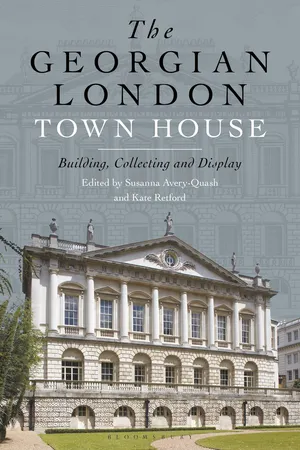![]()
Part One
Architecture, Furnishing, Decorating
![]()
1
A House Divided
Building Biographies and the Town House in Georgian London
Matthew Jenkins and Charlotte Newman
This chapter will focus on the study of middling and genteel Georgian town houses in London. It will explore the potential of archaeological approaches to these houses and how these can illuminate the day-to-day experience of domestic living. It takes as a case study No 43, Parliament Street in Westminster and explores how the various inhabitants influenced the use of space in this ‘political house’. As outlined by the volume editors, the investigation of these houses and the social practices related to them has started to attract increasing research in recent years. However, this research has been primarily conducted by historians and social geographers, with little consideration of the houses themselves, particularly regarding the physical evidence and the material implications of spaces. Studies of urban space have revealed the complexity behind urban improvements and how such improvements were frequently not universal when examined on a street-by-street basis, with older architecture lingering long into the Georgian period.1 Equally, the field of Georgian interiors has investigated how these spaces were experienced by contemporaries and as venues for the performance of everyday life.2 Amanda Vickery has argued convincingly against a strict segregation between public and private, noting that the ‘genteel home was not in any simple sense “off-stage’’’.3 This study joins with those seeking to develop a more nuanced picture of eighteenth-century urban spaces, with a focus on building fabric.
If we are going to investigate the houses themselves, how does the material evidence fit into this picture? The neglect of the middling and genteel town house by archaeologists and architectural historians has also had the unfortunate side effect of undermining the value of the physical evidence of the buildings for some historians. Tim Meldrum, in his otherwise excellent study of domestic service, has warned against architectural determinism and argued that concepts such as privacy ‘cannot be read straight from the fabric of contemporary buildings’.4 This is a case that has then been repeated by other scholars.5 Most buildings archaeologists would agree that social relations cannot be simply ‘read’ from a house and there is a theoretically informed body of work, largely relating to the medieval and early modern periods, that offers a variety of approaches to spatial analysis and the examination of social space.6 Indeed, the theories of Giddens, Bourdieu and Goffman are starting to be taken up by historians, although unfortunately with little engagement with or awareness of how buildings archaeologists have been applying these ideas for decades.7 As noted in this book’s introduction, it is not by privileging one source over the other but by combining physical and documentary evidence that a more fruitful way forward can be developed.
It is by moving from large-scale narratives of urban improvement and privacy to look at qualitative data that historians such as Vickery and Meldrum have begun to analyse the complexity of domestic space.8 The use of diaries, letters, household accounts and court records has allowed the exploration of how interiors were experienced on an everyday level. A similar call has been made in historical archaeology. Charles Orser has advocated for archaeologists to ‘think globally, dig locally’9 and Dan Hicks has highlighted the importance of moving between small-scale studies and grand narratives.10 It is this combination of micro- and macro-level studies, exploring detailed case studies in the light of national data sets, that allows for a comprehensive exploration of the messiness and contradictions of lived experience and the complexity of how people engage with material culture. It is the telling of these ‘stories that “matter”’ that allows for a more nuanced understanding of improvement, privacy and Georgianization.11
In archaeology, this focus has gone hand-in-hand with the development of biographical approaches. Again, the use of this term has the potential for interdisciplinary confusion. Dana Arnold has highlighted the problems associated with biography in traditional architectural history interpretation, whereby a building is explained simply through the biography of a patron or architect.12 This is distinct from archaeological biographies that have been rapidly gaining popularity as a fruitful method of exploring a wide range of material culture.13 A crucial component of this approach is an uncovering of the reflexive relationship between people and their environment, analysing how the larger social context relates to the particular set of circumstances and material culture – the messiness that Hicks articulates.14 This also encompasses the life story of a building or landscape and how it has developed over time.15 This chapter utilizes both material and documentary evidence to explore how the house and the owner interacted with each other, the building both reflecting and helping to structure social relations.
Sources of Evidence
Several key institutions hold archives connected to the materiality of the London town house. Within London, the London Metropolitan Archive and local borough archives such as the City of Westminster Archive Centre hold plans, photographs and insurance document...
